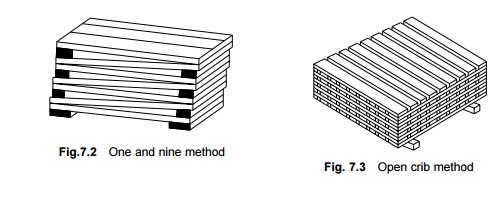Chapter: Civil : Railway Airport Harbour Engineering : Railway Engineering : Sleepers
Treated and Untreated Sleepers

Treated and Untreated Sleepers
Wooden sleepers are also
sometimes classified as hard wood and soft wood sleepers depending upon the
origin or species of the wood of which these are made. Broadly speaking, timber
produced from trees with broad leaves is known as hard wood and that
obtained from trees bearing long leaves is considered soft wood. Some of
the hard wood varieties also require treatment before being used in the track.
As per the recommendations of the committee, the use of the terms 'durable' and
'non-durable' as well as 'hard' and 'soft' should be done away with to avoid
confusion. The committee recommended that for simplification and
rationalization, wooden sleepers should be classified in two categories:
(a) 'U' or Untreated
sleepers comprising of all the sleepers made of wood from naturally durable
species.
(b) 'T' or Treated
sleepers consisting of the rest of the sleepers.
Treatment
of sleepers
Indian
Railways has set up four sleeper treatment plants at the locations given below
for treating non-durable sleepers:
Dhilwan
(Punjab) in Northern Railways 1923
Naharkatia
(Assam) in North Frontier 1928
Clutterbuckganj
(UP) in North East 1955
Olvakot
(Kerala) in Southern Railways 1957
All these plants utilize the
pressure treatment process and the preservative is forced into the wood under
pressure using any one of the following three methods.
Full cell
(Bethell) process In the Bethell process, a cylinder loaded
with the charge for about 300-400 sleepers is first subjected to
a vacuum of 55-60 cm of mercury for 20-30 minutes by means of a vacuum pump.
Hot creosote oil is then forced into the cylinder at a pressure of 150-180 psi
at a temperature of 180 o F. This pressure is maintained for a period of 50-70
minutes till the desired amount of absorption is obtained. Thereafter, the
pressure is reduced and the cylinder is drained off the creosote oil. A final
vacuum of 55 cm of mercury is applied to free the timber of excess preservative.
The whole process takes about 2-3 hours. This process is normally used when
maximum retention of creosote oil is required for a particular type of sleeper
such as that made of kail, deodar, fir, etc. At present this method is in use
in Olvakot, Clutterbuckganj, and Dhilwan plants for various types of wood.
Empty cell (Rueping) process In the
Rueping process, wooden sleepers loaded into the cylinder are
first subjected to an initial air pressure of 3.5 to 5.25 kg/cm2 for
about 20-30 minutes. Afterwards, without reducing the pressure, hot creosote
oil is forced into the cylinder at a temperature of 180 o C to 210 o C. The
pressure is then raised to a value of 10.5-19.6 kg/cm 2 and
maintained for a period of 20-30 minutes till the desired absorption is
achieved. Finally, the pressure is released, the cylinder is drained off the
creosote, and a final vacuum of 55 cm of mercury is created to drain off the
excess preservative. The whole process of treatment takes about 2-3 hours per
charge. This process is generally employed for treating porous timbers and is
used in Dhilwan and Clutterbuckganj depots for chir sleepers. In this process,
air in the cell is entrapped, thereby limiting the preservative to be absorbed
by the sleeper to a certain extent.
Empty cell (Lowry) process In the
Lowry process, the cylinder loaded with timber charge is filled
and then subjected to a pressure of 180 lb, which is sufficient to ensure
proper impregnation. The cylinder is then drained off and the timber subjected
to a final vacuum of 55 cm of mercury for a period of 45 minutes or so. The air
entrapped in the timber cells forces the excess preservative out. Preservative
recovery is greater in this case than in the full cell process but is less than
in the Rueping process. This process is used in the Naharkatia plant for very
green species of timber.
Prophylactic treatment of
sleepers Prophylactic treatment is given to the sleepers by
using patent chemicals such as arsenic pentaoxide, copper sulphate, and
potassium dichromate solution in water 1:3:4 wt (60%) to prevent infection at
the forest head and in the treatment plant. This is necessary an as appreciable
amount of time elapses in transferring the sleepers from the forest depots to
the treatment plant.
Seasoning of sleepers
Wooden sleepers are seasoned to
reduce the moisture content so that their treatment is effective. The Indian
Standard code of practice for preservation of timber lays down that the
moisture content in the case of sleepers to be treated by pressure treatment
should not be more than 25%.
The
seasoning of sleepers can be done by any one of the following processes.
Artificial seasoning in kiln This is a
controlled method of seasoning the timber, normally used in the USA and
other advanced countries, under conditions of temperature and relative
humidity, which are in the range of natural air seasoning.
Boulton or boiling under vacuum
process This is a process in which unseasoned wood is treated
with hot preservative to remove the moisture content. This is adopted in the
Naharkatia depot.
Air
seasoning This is the method adopted extensively for the seasoning of
wooden sleepers in India. The sleepers are stacked in the timber yard
and a provision is made for enough space for the circulation of air in between
the sleepers. The sleepers are stacked in any one of the following ways:
(a) One and
nine method (Fig. 7.2)
(b) Close
crib method
(c) Open crib
method (Fig. 7.3)
Normally, the one and nine method
is adopted on Indian Railways for stacking the sleepers. About 6 months are
required to air season the timber fully by this method.
Related Topics